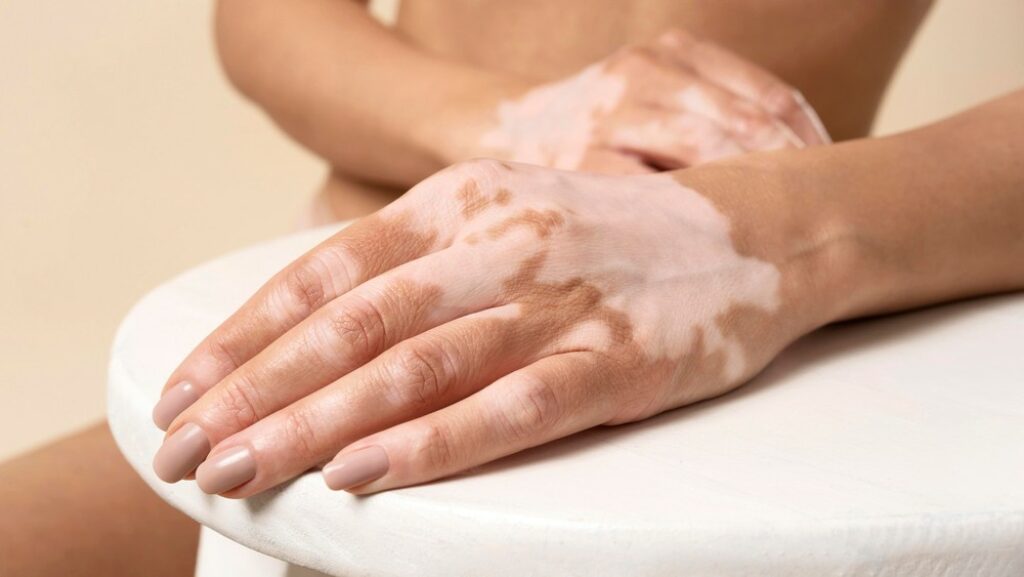
Common Vitiligo Symptoms
While diseases and bad conditions are never pleasant, most of them remain “private” to you and your loved ones. However, there are certain maladies that are not only unpleasant, but also embarrassing, because they are readily visible to others. Skin diseases, like Vitiligo, are such an example.
Related Topics (Sponsored Ads):
Vitiligo is a chronic, long-term skin condition that is caused by the loss of pigment-producing cells (melanocytes), leading to the development of white patches on the skin. These patches can appear on various parts of the body, including the face, hands, feet, arms, and genital area. This article will discuss the common symptoms of vitiligo, its risk factors, and available treatment options.

Symptoms
The primary symptom of vitiligo are distinct white patches on the skin, which may gradually enlarge or spread over time. These patches are usually milky-white or pale in color and can vary in size and shape. Common areas affected include the face, hands, feet, arms, and genitalia. The extent and progression of the condition vary from person to person, and some individuals may experience additional symptoms such as:
– Loss of color in hair and eyebrows: In addition to depigmented skin patches, vitiligo may cause premature graying or whitening of hair and eyebrows. This is known as leukotrichia.
– Whitening of mucous membranes: Some individuals with vitiligo may also observe a loss of pigmentation in the mucous membranes, such as the inside of the mouth, nose, and genitals.
Risk Factors
While the exact cause of vitiligo is not fully understood, several risk factors have been identified that may contribute to its development. These include:
– Autoimmune disorders: Vitiligo is commonly associated with autoimmune diseases, such as thyroid disorders, rheumatoid arthritis, type 1 diabetes, and psoriasis. The immune system mistakenly attacks melanocytes, leading to their destruction.
– Family history: A family history of vitiligo increases the likelihood of developing the condition. Genetic factors may play a role in its onset.
– Triggering events: Certain environmental or physiological triggers, such as sunburn, emotional stress, chemical exposure, or a traumatic event, have been associated with the onset or exacerbation of vitiligo in some individuals.
Associated Conditions
Vitiligo has been associated with other medical conditions. It is more common in individuals with autoimmune disorders, as mentioned earlier. Other associated conditions include alopecia areata (patchy hair loss), pernicious anemia (a decrease in red blood cells), and Addison’s disease (adrenal gland insufficiency). These associations suggest shared underlying mechanisms and immune dysregulation.
Diagnosing Vitiligo
If you notice any depigmented patches on your skin, it is essential to consult a dermatologist for a proper diagnosis. The dermatologist will examine your skin and may use a Wood’s lamp, which emits ultraviolet light, to determine the extent of depigmentation. In some cases, a skin biopsy may be performed to confirm the diagnosis and rule out other skin conditions.
Treatment Options
While there is no cure for vitiligo, several treatment options can help manage the condition and improve the appearance of the affected areas. The choice of treatment depends on various factors, including the extent of the disease, location of the patches, and individual preferences. Common treatment options include:
Topical corticosteroids: These anti-inflammatory creams or ointments are commonly prescribed to reduce inflammation and repigment the affected areas. They are most effective in early-stage or localized vitiligo.
Topical calcineurin inhibitors: These medications, such as tacrolimus or pimecrolimus, help modulate the immune response and may be used in sensitive areas, such as the face or genitals.
Psoralen plus ultraviolet A (PUVA) therapy: This treatment involves the use of psoralen, a light-sensitizing medication, followed by exposure to UVA light. It stimulates repigmentation and is particularly effective for widespread vitiligo.
Narrowband ultraviolet B (NB-UVB) therapy: This treatment utilizes a specific wavelength of UVB light to promote repigmentation. It is often preferred for children and individuals with localized vitiligo.
Excimer laser: This targeted laser therapy delivers concentrated UVB light to the affected areas, stimulating melanocyte activity and promoting repigmentation.
Depigmentation: In extensive or cosmetically challenging cases, depigmentation may be considered. This process lightens the remaining pigmented skin to achieve an even appearance.
Supportive Measures
In addition to medical treatments, individuals with vitiligo can adopt various supportive measures to manage the condition:
Sun protection: Protecting the skin from excessive sun exposure is crucial, as vitiligo patches are more susceptible to sunburn and can worsen with prolonged UV radiation.
Camouflage cosmetics: Cosmetics, such as concealers or self-tanners, can be used to temporarily mask the white patches and improve the appearance.
Counseling and support groups: Coping with vitiligo may involve emotional challenges. Seeking counseling or joining support groups can provide a supportive environment to share experiences and gain emotional support.
Final Thoughts
In conclusion, vitiligo is a skin condition characterized by depigmented patches on the skin. It can affect various body parts and may be associated with autoimmune disorders. A proper diagnosis needs a dermatologist’s evaluation and while there is no cure, various treatment options exist to manage the condition and improve the appearance of the affected areas. A dermatologist can provide a personalized treatment plan based on the individual’s condition and treatment options include topical medications, light therapies, and depigmentation. Also, psychological support is usually crucial for individuals living with vitiligo to address the negative emotional impact of the condition.




